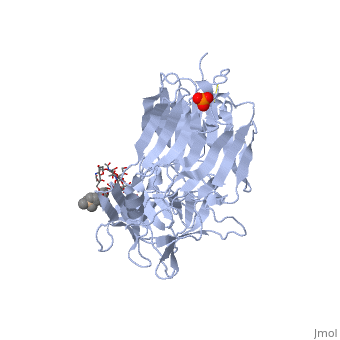Sandbox maybe Sick Page
From Proteopedia
(Difference between revisions)
| Line 21: | Line 21: | ||
The Gram positive bacilli ''Clostridium tetani'' is the bacteria responsible for the disease state of tetanus. The presence of the bacteria does not cause the disease but instead the toxins it produces cause the disease state. ''C. tetani'' produces two toxins; '''tetanospasmin''' and '''tetanolysin''' or '''tentoxylysin'''. Tetanolysin is a cytolysin that increases the | The Gram positive bacilli ''Clostridium tetani'' is the bacteria responsible for the disease state of tetanus. The presence of the bacteria does not cause the disease but instead the toxins it produces cause the disease state. ''C. tetani'' produces two toxins; '''tetanospasmin''' and '''tetanolysin''' or '''tentoxylysin'''. Tetanolysin is a cytolysin that increases the | ||
permeability of cellular membranes through cell lysis.<ref> PMID: 2404569</ref> Tetanospasmin is the cause of tetanus and is sometimes referred to as tetanus neurotoxin (TeNT), as it acts on the central nervous system. Tetanospasmin makes its way to the central nervous system via retrograde axonal flow beginning with α- motor neurons found in muscle and ending by binding to | permeability of cellular membranes through cell lysis.<ref> PMID: 2404569</ref> Tetanospasmin is the cause of tetanus and is sometimes referred to as tetanus neurotoxin (TeNT), as it acts on the central nervous system. Tetanospasmin makes its way to the central nervous system via retrograde axonal flow beginning with α- motor neurons found in muscle and ending by binding to | ||
| + | |||
| + | |||
| + | |||
== Function == | == Function == | ||
Revision as of 08:34, 18 August 2024
Your Heading Here (maybe something like 'Structure')
| |||||||||||
References
- ↑ Hanson, R. M., Prilusky, J., Renjian, Z., Nakane, T. and Sussman, J. L. (2013), JSmol and the Next-Generation Web-Based Representation of 3D Molecular Structure as Applied to Proteopedia. Isr. J. Chem., 53:207-216. doi:http://dx.doi.org/10.1002/ijch.201300024
- ↑ Herraez A. Biomolecules in the computer: Jmol to the rescue. Biochem Mol Biol Educ. 2006 Jul;34(4):255-61. doi: 10.1002/bmb.2006.494034042644. PMID:21638687 doi:10.1002/bmb.2006.494034042644
- ↑ Hatheway CL. Toxigenic clostridia. Clin Microbiol Rev. 1990 Jan;3(1):66-98. PMID:2404569

